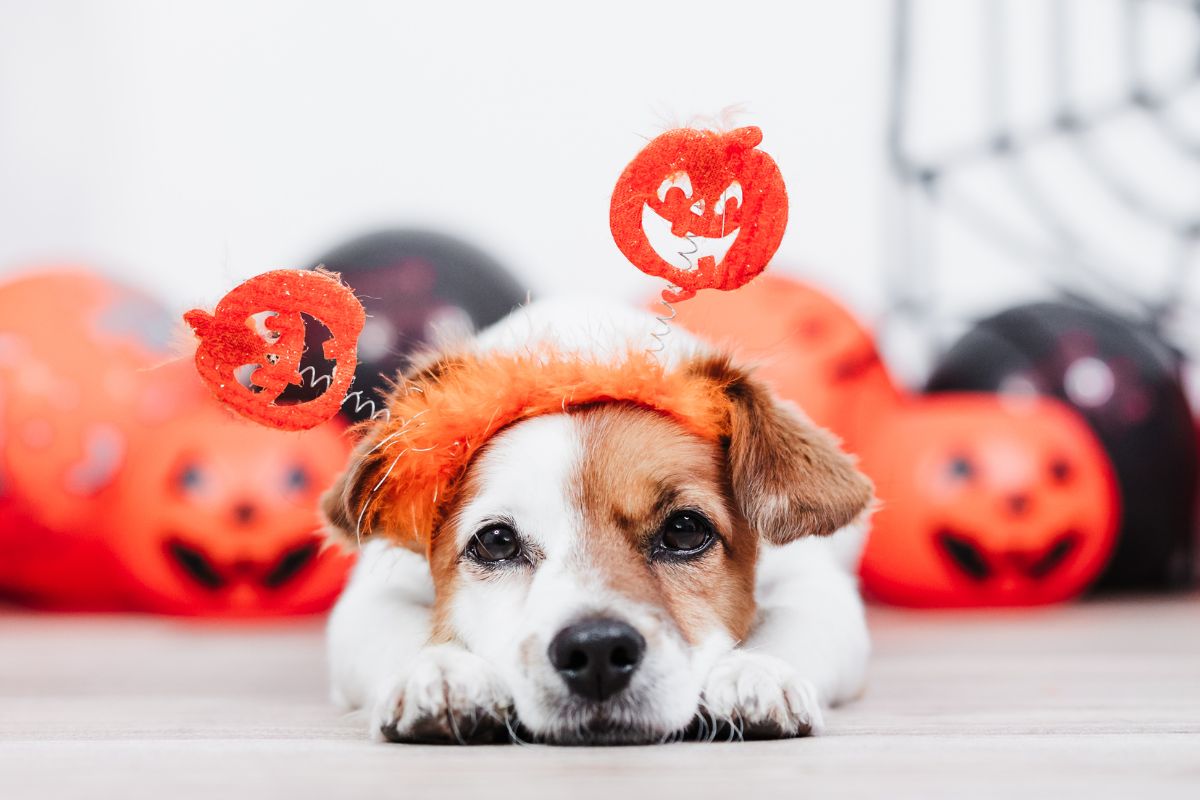October is all about spooky vibes: dark corners, flickering lights, and things that go bump in the night. It’s a perfect metaphor for what many puppies experience daily: little fears that loom large in their minds. For your puppy, the world can feel like one big haunted house. The vacuum growls, strangers wear masks, thunder shakes the sky… it’s a lot!

These everyday “spooks” can send your pup into hiding. But just like ghost stories don’t last past bedtime, puppy fears don’t have to be permanent. With patience, compassion, and smart training moves, your little ghoul can grow into a confident companion who isn’t afraid of life’s everyday “monsters.”
Signs Your Puppy’s Feeling Spooked
Before we slay these spooky fears, here’s how to spot the early tremors. A fearful puppy might:
- Cower, tremble, or tuck their tail
- Freeze in place, try to hide, or back away
- Lick lips, pant heavily, or avoid eye contact
- Whine, bark nervously, or adopt a stiff posture
- Growl or snap if cornered (defensive, not malicious)
These aren’t bad behaviors; rather, they’re cries for help. Recognizing them early is the first step to helping your pup feel safe again.
8 Common Puppy Fears (And How You Can Be Their Ghostbuster)
- The “Monster” Vacuum & Other Loud Appliances
The vacuum is basically a roaring beast to a puppy. Instead of firing it up full-blast, start small: roll it around quietly, let your pup sniff it while it’s off. Next, turn it on in another room and give your pup a cozy safe spot to retreat to. You can even make it fun: toss a squeaky toy or play gentle music while it’s running so the noise blends into a normal background. - Thunderstorms and Fireworks
For noise-phobic pups, storms feel like the sky is growling. Try turning these moments into “quiet cuddle sessions” with calm music, gentle massage, or a vet-recommended anxiety wrap like a Thundershirt. Close curtains, create a cozy den, and keep your own demeanor chill; dogs read your emotions like a book. - Shadows, Reflections, and Flickering Lights
A wagging tail in the mirror? A shadow that moves “on its own”? Terrifying! Encourage curiosity instead of fear. Walk over with them, show the light source, and let them explore. Sometimes just turning on an extra lamp or playing shadow games with treats can teach them that not everything that moves is a threat. - Strangers, Hats, Masks & Costumes
Big coats, sunglasses, Halloween masks, they’re confusing! Start with friends your pup knows. Have them put on a hat or mask and sit calmly nearby, tossing a toy or chatting in a friendly voice. Gradually introduce different outfits during walks so your pup gets used to human “transformations.” - The Dreaded Vet or Grooming Table
Slippery surfaces, weird smells, people touching their paws… Yikes! Recreate the environment at home with short “pretend vet visits.” Touch their ears, check their paws, gently hold them still, then reward calm behavior. Play vet-friendly handling games so they associate touch with safety, not stress. - Other Dogs and Animals
For social anxiety, slow introductions are key. Walk parallel at a distance before meeting face-to-face. Use calm body language, let them sniff from afar, and praise relaxed posture. Group puppy classes are a great controlled way to build confidence too. - New Floors or Surfaces
Metal grates, tile, or shiny floors can feel like ice rinks to nervous paws. Try laying towels or mats for traction, then gradually shorten the “safe path.” You can even scatter kibble trails so exploration feels like a fun adventure, not a horror movie. - Being Left Alone
Separation anxiety isn’t just fear; it’s heartbreak for a puppy who hasn’t learned solitude. Start by leaving them for seconds at a time, returning calmly, no big fuss. Give them puzzle feeders or a shirt that smells like you. Calm departures and low-key reunions teach them that you always come back.
Extra Tricks for Tackling Puppy Fears
- Use counterconditioning: Pair scary stimuli with positive things (treats, play). Your pup learns “monster = good stuff.”
- Break training into tiny steps: Don’t rush. Let your pup decide when they’re ready to inch closer.
- Short, frequent sessions: Five minutes of gentle exposure is more effective than one 30-minute session.
- Stay calm, neutral, confident: Your energy affects them. If you panic, they will too.
- Avoid punishment or pressure: Forcing or scolding fear makes it worse. Always respect their limit.
- Celebrate small wins: Even a glance toward the “monster” or a step forward is progress. Treat accordingly.
- Consider professional help: If a fear becomes full-blown phobia (constant panic, unsafe behavior), a behaviorist or vet should guide deeper intervention.
Every puppy has their “haunted house” moments. But behind each fear is a chance to build trust. When your pup learns that you’re their safety net, even the scariest vacuum or thunderclap becomes less monstrous. So this spooky season, don’t chase away their fears. Help them face them. With love, patience, and a sprinkle of play, your pup will soon realize the world isn’t so scary after all. It’s just full of adventures waiting to be sniffed out.
